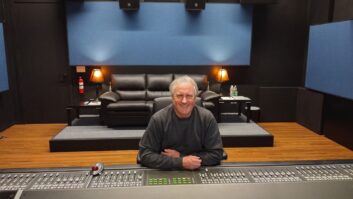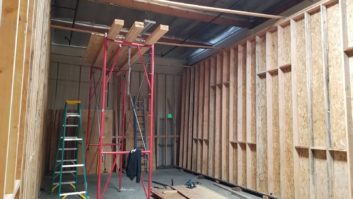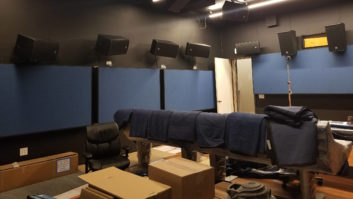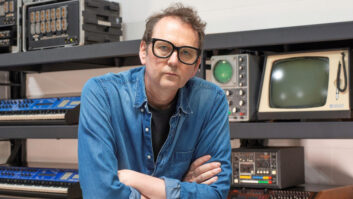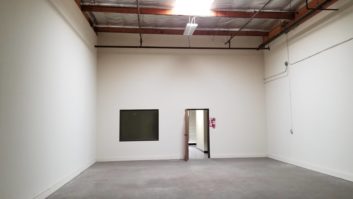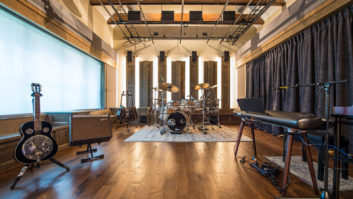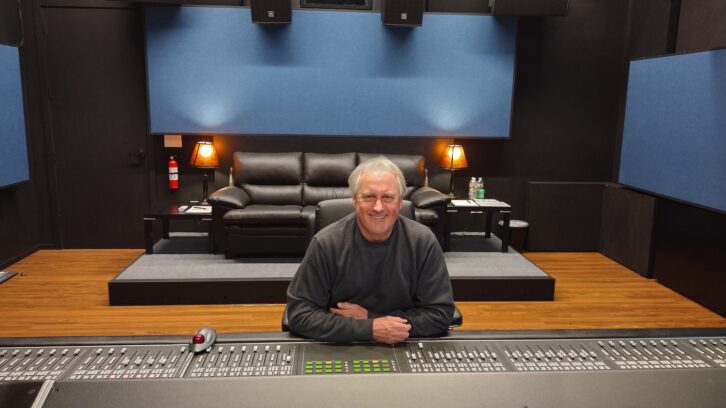
It wasn’t the daily Los Angeles commute, the ongoing workflow changes in audio post-production, or even the disruption and frustration brought on by the COVID shutdowns that led film mixer Paul Massey to build a 9.1.6 studio in Ventura. It was simply that he wanted to spend more time with his family.
It’s the same reason as in 2010, when he built his first personal studio—a high-end 5.1 film mix room in Ojai, about 75 miles north of Los Angeles; he even carried forward much of his signal chain, from console to monitors. There is, however, one rather big difference aside from the switch to immersive playback.
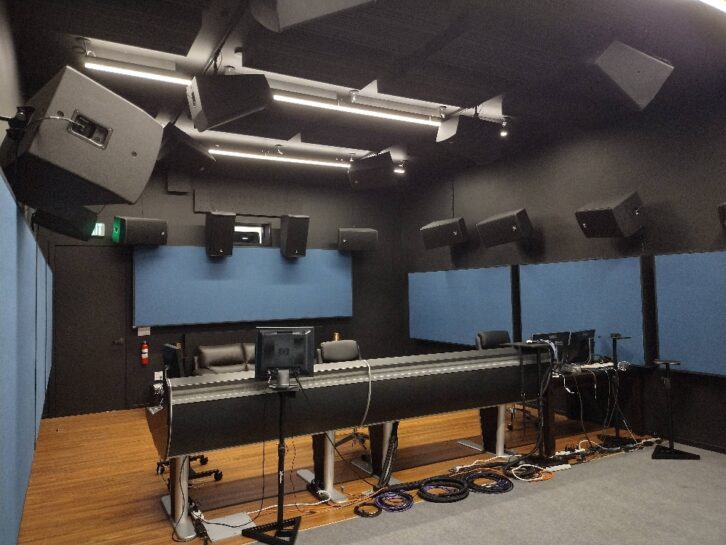
From 2010 to 2020, he would walk out the back door of his home with a cup of coffee and amble down a path to a free-standing, ground-up studio he had built on the property at the same time the house went up. Now he drives about 20 minutes to a converted warehouse space in Ventura, and then drives home through a beautiful, rolling landscape. He seems quite happy, though when asked about work-life balance, he chuckles softly and admits, “I’m trying. It’s baby steps.
“When we moved to Ojai, it was about figuring out how to get pre-dubbing and other small work so that I could spend more time with my family,” Massey says. “So we built a professional 5.1 room. But, honestly, when I was at home and said, ‘I’m going over to the studio for an hour or two,’ I would be there all day tweaking around. I’m taking away time that I should be spending with the family.
“When we moved a couple of years ago, I looked at building another studio on our home lot,” he continues. “Then one day my wife said, ‘You know, why don’t you look for space that’s not at home?’ and it turned out to be a really good suggestion. It means that now when I go to work, I’m going there to work and I’m going there for a reason. I’m not going to waste time there and fiddle around all day long. And then when I’m home, I’m home, which is great. I think it’s worked out well.”
BUILDING A REFERENCE POINT
When we talked in early January, Massey had just returned from a quick four-day hop to London to work on an ongoing mix and was ready to start a project at Warner Bros. in Burbank the following week. As soon as we finished the interview, he was back at his own Harrison MPC5 console, cleaning up a dialog predub for another project. Life at the top of the film re-recording world involves long, long daily hours over extended chunks of time, often many weeks. Massey estimates that during the past six or seven years, 75 percent of his work has been in Los Angeles, much of it at the John Ford Theater on the Fox lot, with the other 25 percent in London.
While having a personal, professional studio near home serves to balance the Life side of the ledger from the Work side, its true value is in providing Massey with a sense of consistency—an audio reference point all his own for when he carries his predubs to the final mix at Fox or Sony or Twickenham, or when he takes into consideration the multitude of streaming services and home playback environments. It was important to him that the new studio be certified for both Dolby Atmos Cinema and Home out of the same playback system. And it is.
“Translation is going to be about 90 percent of what we all do,” Massey says bluntly. “If a room doesn’t translate to where the audio is going to ultimately end up for the average listener, then what’s the point? I think it’s of the utmost importance that cinemas stay open and we still make soundtracks for theatrical release. But the simple truth is that an awful lot of the audience now is watching from the streaming platforms, and that has necessitated changes in the way we mix and changes in the room sizes that we are mixing in, so that they more accurately transition and translate into what the audience is watching.”
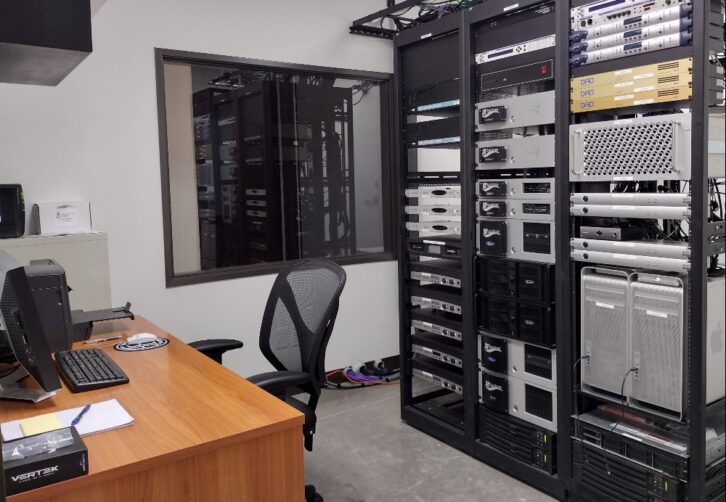
AN ACOUSTIC FOUNDATION
Massey had known Bruce Black for many years as they both built careers in film sound, with the former typically at the console and the latter in the machine room. On the side, over many years, Black had become a self-educated acoustician and would occasionally engage in casual conversations with Massey about what he’d been learning and how he had been forming his own theories. When Massey was preparing for the move to Ojai, he recalled those chats and brought Black onboard for the acoustic design. He brought him back in 2020 for the move to Ventura.
“I talked to a bunch of acoustic designers at the time, and some of them made things so complicated and so unnecessary,” Massey remembers. “Acoustically, I just thought there’s got to be a better way, a simpler way, a less-is-more way. Then I started talking to Bruce again, but as an acoustic designer and about how he overcomes issues. Bruce is definitely less-is-more, and he came up with some genuine, unique ways of dealing with acoustic issues. He’s very, very talented.”
Black is also one of those unique audio industry characters. He’s a man of science, with a can-do attitude and quirky sense of humor. Now semi-retired, he’s freer to further develop his theories and techniques, which are based on direct observation and collected data. These sometimes differ from common practice, but he sticks with what he’s learned and developed on his own.
Isolation is paramount to Black (“you want the outside sound to stay outside and the inside sound to stay inside”), and he considers calling it soundproofing misleading. He also balks at bass traps to treat the low end (“It essentially turns all the lows down; instead, just focus on the specific problems and leave everything else alone”) in favor of Helmholz-style resonators, whether a single hole in a box for the deep lows or multiple perforations to treat the upper lows.
Cinema Audio Society Announces Sound Mixing Nominations
He absolutely believes in sturdy structure (“Screws every four inches instead of building code’s spec of up to 16 inches”), and he is chagrined when talking about the preponderance of “flimsy screen walls” that he comes across (“Any energy that gets into them is going to vibrate the wall, essentially making it another speaker that is nowhere near as high fidelity—plus it has a time delay in it”). He leaves the application of EQ to the very end of the process because, he says, there are a lot of acoustic issues that EQ can’t fix (“Response depends on where you measure—if you EQ for the mix position, the response of the room changes as you move, and I’ve never met a mixer who stays in just one place; they’re always moving around”).
All of the above approaches were employed in one way or another in the construction of Massey’s new studio. The design, treatment and tuning—based on frequency, waterfall and decay graphs—was an iterative and collaborative process throughout the two years of planning, four-month build, and the first few months after its soft opening in July 2022.
“I build to numbers and graphs and data like that because that makes the process repeatable and quantifiable,” Black explains. “Once that’s done, Paul does his listening test and he says, ‘Well, I hear a little something here, I’m getting a little something there,’ and we address that. Basically we’re tuning the room to his ears. Paul works in many different studios, and he needs to be confident that what’s on the recorded medium sounds consistent between the rooms that it’s being played in.”

